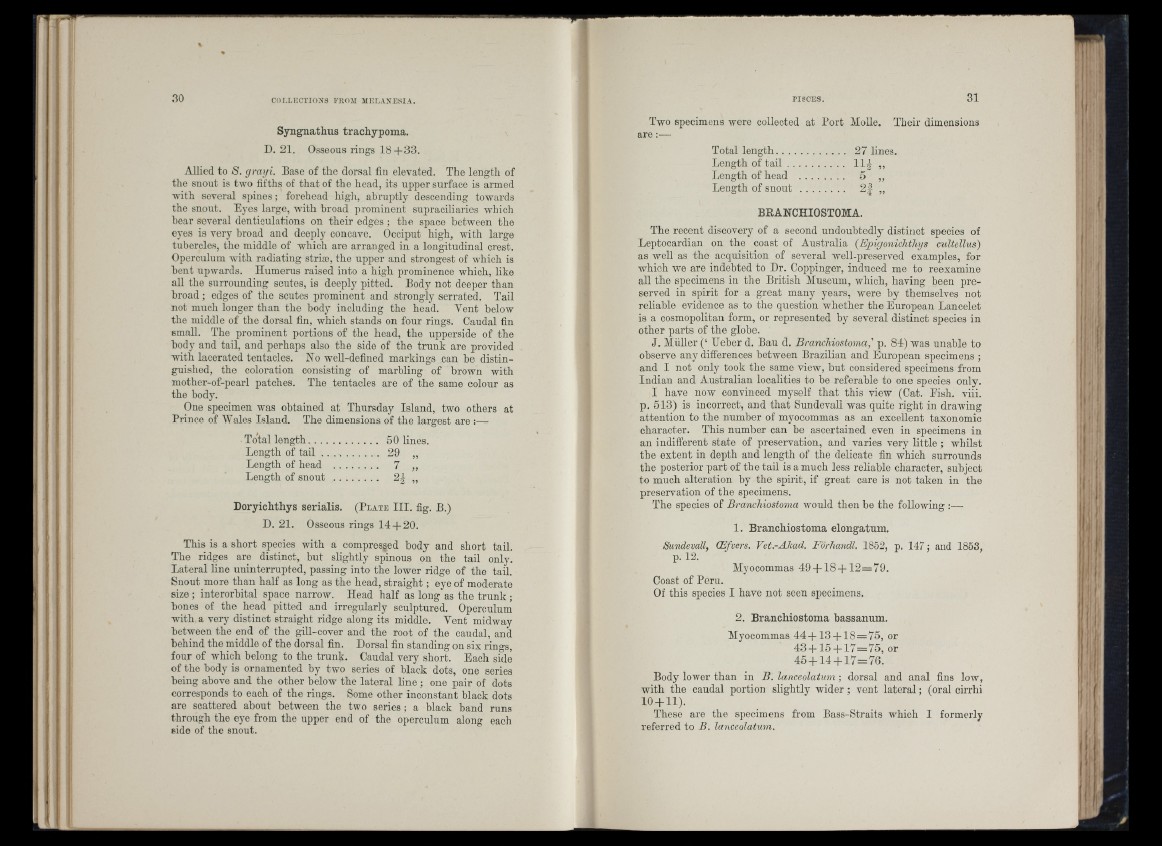
Syngnathus trachypoma,
D. 2 1 . Osseous rings 1 8 + 3 3 .
Allied to S. grayi. Base of the dorsal flu elevated. The length of
the snout is two fifths of th a t of tho head, its upper surface is armed
with several spines ; forehead high, abruptly descending towards
the snout. Eyes large, with broad prominent supraciliaries which
hear several dentieulations on their edges ; the space between tho
eyes is very broad and deeply concave. Occiput high, with large
tubercles, tho middle of which are arranged in a longitudinal crest.
Operculum Avith radiating striæ, tho upper and strongest of Avhich is
bent upwards. Humerus raised into a high prominence Avhich, like
all the surrounding scutes, is deeply pitted. Body not deeper than
broad ; edges of the scutes prominent and strongly serrated. Tail
not much longer than the body including the head. Vent beloAV
the middle of the dorsal fin, which stands on four rings. Caudal fin
small. The prominent portions of the head, the upperside of the
body and tail, and perhaps also the side of the trunk are provided
with lacerated tentacles. No well-defined markings can he distinguished,
the coloration consisting of marbling of brown with
mother-of-pearl patches. The tentacles are of the same colour as
the body.
One specimen was obtained at Thursday Island, two others at
Prince of Wales Island. The dimensions of the largest are :—
Total len g th ............................. 50 lines.
Length of t a i l ......................... 29 „
Length of head ................. 7 ,,
Length of snout ................ „
Doryichthys serialis. (Plate I I I . fig. B.)
D. 21. Osseous rings 1 4 + 2 0 .
This is a short species with a compressed body and short tail.
The ridges are distinct, but slightly spinous on the tail only.
Lateral line uninterrupted, passing into the lower ridge of the tail.
Snout more than half as long as the head, straight ; eye of moderate
size ; interorhital space narrow. Head half as long as the trunk ;
bones of the head pitted and irregularly sculptured. Operculum
with a very distinct straight ridge along its middle. Vent midway
between the end of the gill-cover and the root of the caudal, and
behind the middle of the dorsal fin. Dorsal fin standing on six rings,
four of which belong to the trunk. Caudal very short. Each side
of the body is ornamented by two series of black dots, one series
being above and the other below the lateral line ; one pair of dots
corresponds to each of the rings. Some other inconstant black dots
are scattered about between the two series ; a black band rims
through the eye from the upper end of the operculum along each
side of the snout.
Two specimens Avere collected at Port Molle. Their dimensions
are —
Total len g th ........................... 27 lines.
Length of t a i l ...................... 11^ „
Length of head ................ 5 „
Length of snout ................ 2 | ,,
BRANCHIOSTOMA.
The recent discovery of a second undoubtedly distinct species of
Leptocardian on the coast of Australia (EpigonicJithys cultellus)
as well as tho acquisition of several well-preserved examples, for
which AA^e are indebted to Dr. Coppinger, induced me to reexamine
all the specimens in the British Museum, which, having been preserved
in spirit for a great many years, were by themselves not
reliable evidence as to the question whether the European Lancelet
is a cosmopolitan form, or represented by several distinct species in
other jiarts of the globe.
J. Miiller (‘ Ueber d. Ban d. Branchiostoma,' p. 84) was unable to
observe any differences between Brazilian and European specimens ;
and I not only took the same view, but considered specimens from
Indian and Australian localities to be referable to one species only.
I have now convinced myself th a t this view (Cat. Fish. viii.
p. 513) is incorrect, and that Sundevall was quite right in draAving
attention to the number of myocommas as an excellent taxonomic
character. This number can be ascertained even in specimens in
an indifferent state of preservation, and varies very little ; whilst
the extent in depth and length of the delicate fin which surrounds
the posterior part of the tail is a much less reliable character, subject
to much alteration by the spirit, if great care is not taken in the
preservation of the specimens.
The species of Branchiostoma would then be the following ;—
1. Branchiostoma elongatum.
Sundevall, (Efvers. Vet.-Akad. Forhandl. 1852, p. 147; and 1853,
p. 12.
Myocommas 49 + 18 + 12—79.
Coast of Peru.
Of this species I have not seen specimens.
2. Branchiostoma bassanum.
Myocommas 44 + 13 + 18 = 75, or
43 + 15 + 1 7 = 7 5 , or
45 + 14 + 1 7= 7 6 .
Body lower than in B. lanceolatum : dorsal and anal fins low,
with the caudal portion slightly wider ; vent la te ra l; (oral cirrhi
10 + 11).
These are the specimens from Bass-Straits Avhich I formerly
referred to B. lanceolatum.
i|l ;|M
iiÏ